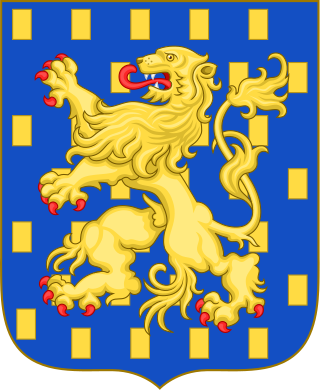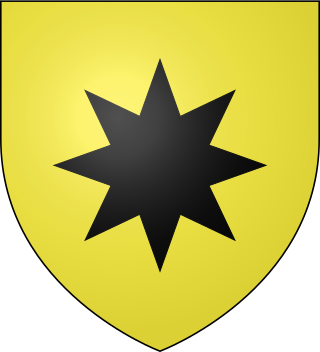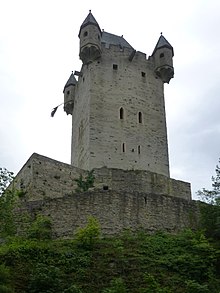
The House of Nassau is a diversified aristocratic dynasty in Europe. It is named after the lordship associated with Nassau Castle, located in present-day Nassau, Rhineland-Palatinate, Germany. With the fall of the Hohenstaufen in the first half of the 13th century royal power within Franconia evaporated and the former stem duchy fragmented into separate independent states. Nassau emerged as one of those independent states as part of the Holy Roman Empire. The lords of Nassau were originally titled "Count of Nassau", subject only to the Emperor, and then elevated to the princely class as "Princely Counts". Early on they divided into two main branches: the elder (Walramian) branch, that gave rise to the German king Adolf, and the younger (Ottonian) branch, that gave rise to the Princes of Orange and the monarchs of the Netherlands.
Walram II of Nassau was Count of Nassau and is the ancestor of the Walramian branch of the House of Nassau.
Henry II "the Rich" of Nassau was Count of Nassau. He distinguished himself in particular by his chivalrous and devout spirit. He was charitable and made great donations to the church, so that the monasteries and prayer houses in the area of present-day Nassau experienced the most significant bloom in his time. The greatest favour was the Teutonic Order to enjoy, to which he donated especially for the renunciation of his brother's, upon his entry into the order. Henry participated in the Sixth Crusade. He was the builder of the castles Sonnenberg, Ginsburg and Dillenburg.
Otto I of Nassau was Count of Nassau and is the ancestor of the Ottonian branch of the House of Nassau.
Dudo of Laurenburg, German: Dudo von Laurenburg, Latin: Tuto de Lurinburg, was probably Count of Laurenburg and is considered the founder of the House of Nassau. The House of Nassau would become one of the reigning families in Germany, from which are descended through females the present-day royals of the Netherlands and Luxembourg, while officially belonging to this House.
Rupert I of Laurenburg, German: Ruprecht I. von Laurenburg, was count of Laurenburg and one of the ancestors of the House of Nassau.
Walram I of Nassau, German: Walram I. von Nassau, also known as Walram I of Laurenburg, was Count of Nassau and is the oldest Nassau whose ancestorship is absolutely certain. He managed to expand his territory considerably during his reign. He took part in the Third Crusade.
Rupert III ‘the Bellicose’ of Nassau, German: Ruprecht III. ‘der Streitbare’ von Nassau, was one of the earliest counts of Nassau. He was not without significance for his country. Important government decisions characterize him, but much more important is his more general political activity, making him one of the most striking princes of the House of Nassau. He took part in the Third Crusade.

Count Otto II of Nassau-Siegen, German: Otto II. Graf von Nassau-Siegen, was since 1343 Count of Nassau-Siegen. He descended from the Ottonian Line of the House of Nassau.

Countess Magdalene of Waldeck-Wildungen, German: Magdalena Gräfin zu Waldeck-Wildungen, was a countess from the House of Waldeck and through marriage successively Countess of Hanau-Münzenberg and Countess of Nassau-Siegen.

Count Henry II of Nassau-Siegen, German: Heinrich II. Graf von Nassau-Siegen, official titles: Graf zu Nassau, Vianden und Diez, Herr zu Breda, was since 1442 Count of Nassau-Siegen, of Vianden and of half Diez. He descended from the Ottonian Line of the House of Nassau.
Arnold II of Laurenburg, German: Arnold II. von Laurenburg was count of Laurenburg and one of the ancestors of the House of Nassau.

Rupert II of Laurenburg, German: Ruprecht II. von Laurenburg was count of Laurenburg and one of the ancestors of the House of Nassau.
Henry I of Nassau, German: Heinrich I. von Nassau, was the first person who named himself count of Nassau.
Herman of Nassau, German: Hermann von Nassau, was count of Nassau. He later became a clergyman.
Beatrix of Limburg, was a German noblewoman who probably for a while acted as regent of the county of Laurenburg for her grandsons, who later became counts of Nassau.
Prima Divisio is the term used by historians for the Family Treaty from 1255 containing the first division of the county of Nassau between the brothers Walram II and Otto I.

Gerhard of Nassau was a clergyman from the House of Nassau. He was probably the first Nassau in the Netherlands.
Rupert was Vogt at Siegen and is one of the eldest known possible ancestors of the House of Nassau.
Elizabeth of Leiningen, German: Elisabeth von Leiningen, was a countess of the House of Leiningen and by marriage countess of Nassau. As widow she used the title countess of Schowenburg.






